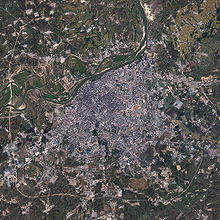Harbin
![]()
The title of this article is ambiguous. For other meanings, see Harbin (disambiguation).
Harbin (Chinese 哈爾濱市 / 哈尔滨市, Pinyin Hā'ěrbīn Shì, W.-G. Ha-erh-pin; Manchurian ᡥᠠᠯᠪᡳᠨ; Russian Харби́н / Charbin![]() ) is the capital of Heilongjiang Province (Amur Province), Manchuria, People's Republic of China, on the Songhua Jiang River, with a population of 4,596,313 in the metropolitan area (2010 census). There are 4.8 million in the urban agglomeration and 10.98 million people lived in the total area in 2016.
) is the capital of Heilongjiang Province (Amur Province), Manchuria, People's Republic of China, on the Songhua Jiang River, with a population of 4,596,313 in the metropolitan area (2010 census). There are 4.8 million in the urban agglomeration and 10.98 million people lived in the total area in 2016.
Administrative divisions and population
Administrative division of Harbin
At the county level, the sub-provincial city of Harbin is composed of nine urban districts, two independent cities and seven counties. These are:
|
|
Population development of the agglomeration
According to the UN, just under 6 million inhabitants lived in the actual urban agglomeration of the city (as of 2017). The remaining population lives in the rural hinterland. Due to advancing urbanization, 7.9 million inhabitants are expected to live in the agglomeration by 2035.
| Year | Population |
| 1950 | 726.000 |
| 1960 | 1.423.000 |
| 1970 | 1.696.000 |
| 1980 | 1.992.000 |
| 1990 | 2.515.000 |
| 2000 | 4.100.000 |
| 2010 | 5.140.000 |
| 2017 | 5.984.000 |
Ethnic composition of the total population of Harbin (2000)
The 2000 Census counted a population of 9,413,359 for the entire Harbins administrative area.
| Name of the people | number of inhabitants | Share |
| Han | 8.796.610 | 93,45 |
| Manchurian | 00433.340 | 04,6 |
| Korean | 00119.883 | 01,27 |
| Hui | 00039.995 | 00,43 |
| Mongolian | 00013.163 | 00,14 |
| Xibe | 00004.741 | 00,05 |
| Daur | 00000938 | 00,01 |
| Other | 00004.689 | 00,05 |
History
The city was founded by Russians in 1898 - after the occupation of northern Manchuria by Russia - as a railway station of the Trans-Manchurian Railway, which is why the cityscape of the older parts of the city is still characterized by Russian architecture today. Especially after the October Revolution many Russians fled to Harbin and contributed to the flourishing of the city. In 1932 the city was occupied by Japanese troops. After Japan's surrender in World War II, the Soviet Union took over the city. Although it handed the city over to the Republic of China as agreed, Red Army troops continued to be stationed there. With their tacit acquiescence, the Chinese Communist Party was able to conquer the city as early as 1946. The industrial facilities there served them as a base for victory in the civil war.
After the founding of the People's Republic of China, heavy industry was expanded in Harbin. For this purpose, people from the south of China were resettled here and the Technical University was strengthened by teachers from the south. Many of these people returned to their old home after the relaxation of the housing regulations.
Since the economic reform, Harbin and Heilongjiang Province have been trying to distinguish themselves as a bridgehead in trade with Russia.
In November 2005, the Jilin chemical spill contaminated the waters of the Songhua Jiang with benzene, forcing the city's drinking water supply to be cut off for several days.
On October 20, 2013, a heavy smog spread over Harbin. The airport, schools and kindergartens were closed for three days. All highways were closed after series of accidents. With little wind and relatively warm weather, the coal-fired municipal heating system had been started. On October 25, cold air flowing in from Siberia caused the smog to lift and dissipate.

Satellite image
Search within the encyclopedia